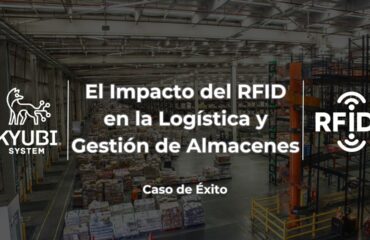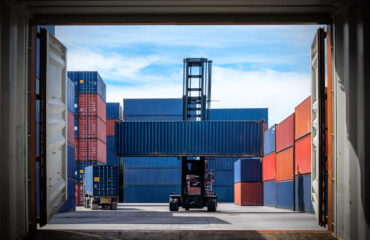
For you, visionary leader: The future of asset, inventory, and supply chain management
It is no longer based on methods that require line-of-sight or manual counts. It’s 2025, and the market demand is clear: speed, accuracy and total, real-time visibility. If slowness, inventory errors or lack of traceability are holding your business back, it’s time to embrace the technology that is redefining operational efficiency: RFID (Radio Frequency Identification).
At Kyubi System, we don’t just implement RFID; we design solutions that radically transform the way you operate, giving you a sustainable competitive advantage. This article is your complete roadmap to understanding the power of RFID and how it can be the key to your next big operational improvement.
What is RFID Exactly? Beyond a Simple Tag
RFID is an automatic identification technology that uses radio waves to capture data from a tag attached to an object. Unlike optical technologies such as barcodes or QR codes, RFID requires no direct line of sight and can read multiple tags simultaneously at various distances. This makes it an exceptionally powerful tool for tracking, managing and automating processes at scale.
Imagine a warehouse where receiving goods does not require box-by-box scanning, but a portal instantly reads an entire pallet. Think of retail inventory control that is automatically updated every time an item moves from warehouse to shop. That’s RFID in action.
The Master Mechanism: How Does an RFID System Work Step by Step?
An RFID system is a symphony of components working in wireless harmony:
- The RFID Reader:
Also known as an interrogator, the reader emits a radio signal of a specific frequency through its antenna. Its purpose is to detect tags within its range.
- The RFID Antenna:
Connected to the reader, the antenna radiates the radio signal from the reader and receives responses from the tags. The design, size and shape of the antenna determine the coverage area and the reading direction.
- The Software/Management System:
The data captured by the reader is sent to a computer system. This software processes the information, filters it, integrates it with existing databases (such as your WMS or ERP) and converts it into useful data for decision making, tracking or process automation.
The Simplified Process:
-
The reader emits a radio signal.
-
A tag within range receives the signal.
-
If the tag is passive, it uses the energy from the received signal to activate its chip. If it is active, it uses its own battery.
-
The tag responds by transmitting its unique ID and any other stored data back to the reader’s antenna.
-
The antenna sends the response to the reader.
-
The reader processes the data and sends it to the computer system.
-
The management system uses the data to update inventories, verify shipments, track assets, etc.
The Key Components Broken Down: Tags, Readers and Antennas
A deeper understanding of each component helps to appreciate the sophistication and flexibility of RFID:
RFID Tags
They are the identifier element. Their type varies greatly depending on the application:
- Passive Tags:
They have no battery. They obtain the energy to operate directly from the radio waves emitted by the reader. They are smaller, less expensive and have a virtually unlimited lifetime. Ideal for labelling large volumes of low-cost products, retail inventory management or document tracking.
- Active Tags:
Contain an internal battery. They emit their own signal, which allows them to have a much longer read range (hundreds of metres) and additional functionalities such as sensors (temperature, humidity). They are more expensive and have a limited battery life. Used for high-value asset tracking, vehicle tracking or environmental monitoring.
- Semi-Passive Tags (or BAP – Battery-Assisted Passive):
Have a small battery to power the chip (not the communication), allowing them to respond faster or incorporate sensors, but communication still relies on the reader signal. They offer a balance between passive and active.
In addition to their power type, tags vary in form (adhesive tags, cards, inlays, rigid tags, special tags for metal or liquids) and memory capacity.
RFID Readers / Interrogators (RFID Readers / Interrogators)
The intelligence of the system at the point of reading. They are mainly classified into:
- Fixed Readers:
Installed in strategic locations such as gates (entrances/exits), control points in production lines, intelligent shelves or conveyor belts. They provide continuous and automated reading in a defined area.
- Mobile Readers:
Portable devices (handheld, forklift-mounted, PDAs). They offer flexibility for dynamic inventory, locating specific items in large spaces or verifying shipments at the point of delivery.
Readers vary in power, number of antenna ports and connectivity capabilities (Ethernet, Wi-Fi, Bluetooth).
RFID Antennas (RFID Antennas)
They are the physical bridge of communication. Their design determines:
- Coverage Area:
How large is the field where tags can be read.
- Directionality:
Whether the signal is focused in one direction (directional antennas) or radiates in multiple directions (omnidirectional antennas).
- Polarisation:
Linear (horizontal or vertical, ideal for known tag orientations) or circular (best for reading tags in random orientations).
Proper antenna selection and positioning are critical system design tasks that require expertise to ensure reliable read coverage in the specific operating environment.
RFID Frequencies: Choosing the Right One Defines Your Application Success
Operating in the right frequency band is vital, as each has unique properties that make it ideal for different scenarios:
- Low Frequency (LF: 30 kHz to 300 kHz, typically 125 kHz):
Characteristics:Short range (few centimetres), low read rate, excellent ability to penetrate liquids and metals (albeit with very limited range).
Typical applications:
Animal identification (cows, pets), basic access control, vehicle immobilisation systems, beer keg tracking.
- High Frequency (HF: 3 MHz to 30 MHz, typically 13.56 MHz):
Features:Moderate read range (up to 1 metre), reasonable read rates, sensitive to metals but less sensitive to liquids than UHF. Supports higher data capacities on the tag.
Typical Applications:
Contactless payments (NFC), ticketing (public transport, events), libraries, secure access control (employee cards), e-passports, retail product identification (with smaller scale inventories), loyalty systems. NFC operates in this band.
- Ultra High Frequency (UHF: 300 MHz to 3 GHz, typically 860-960 MHz in global standards such as EPC Gen2 v2):
Features:Long range (several metres, up to 15+ metres with active tags), high read rate (hundreds of tags/second), more sensitive to liquids and metals than LF or HF (requires specific tags and system designs for these materials).
Typical applications:
High-volume warehouse inventory management, global supply chain tracking, large-scale asset control (pallets, containers, vehicles), electronic tolling, laundry tracking in retail and industrial laundries, reverse logistics. It is the predominant frequency in most modern logistics and industrial applications.
Selecting the right frequency and components is a solution engineering process. An RFID expert like Kyubi System evaluates your environment, the materials involved and your range and speed objectives to design the optimal system.
RFID vs. Barcodes: Understanding the Evolutionary Advantage
| Feature | Barcode | RFID | RFID Advantage |
|---|---|---|---|
| Line of Sight | Direct and unobstructed required | Not required (can read through boxes, etc.) | Higher speed, bulk read, concealment. |
| Simultaneous Reading | One at a time | Hundreds per second | Massive efficiency in counting and inventory. |
| Reading Distance | Short (few cm, up to ~1m with laser) | Variable (cm to tens of metres) | Operational flexibility, remote reading. |
| Data Capacity | Limited (e.g. 12-20 characters) | Larger (long EPCs, additional memory) | More information on the tag, versatility. |
| Re-writable | Not rewritable (generally) | Most tags can be rewritten | Allows updating of information on the tag. |
| Durability | Sensitive to surface damage | More rugged, can be inside objects | Greater reliability in hostile environments. |
| Automation | Limited to scanning points | Highly automatable in process flows | Continuous visibility, less manpower. |
For operations where speed, automation and unobstructed visibility are critical, RFID is the superior technology.
Tangible Benefits: How RFID Boosts Your Bottom Line
- Dramatically Improve Inventory Accuracy:
Reduces manual counting errors to near zero, bringing accuracy to levels of 98-99%+. This eliminates overstocking and understocking.
- Exponential Increase in Operational Efficiency:
Processes such as receiving, inventory and picking become exponentially faster. A physical inventory that used to take days can now be completed in hours.
- Significant Loss Reduction:
Real-time visibility deters theft and reduces shrinkage and misplaced products, protecting your assets.
- Supply Chain Optimisation:
Accurately track products in motion, improve planning, reduce cycle times and optimise the flow of goods.
- Data-Driven Decision Making:
Access to accurate and up-to-date information about your assets or inventory enables smarter and faster decisions.
- Improved Traceability and Compliance:
Ability to track the complete history of an item (where it has been, when, with whom), essential for safety, quality and regulatory compliance in industries such as food, pharmaceuticals and aerospace.
- Improved Customer Experience (in Retail):
Accurate product availability (omni-channel inventory) and faster returns processes.
RFID Applications by Sector: Solutions Tailored to Your Industry
- Logistics and Transportation:
Automated dock management, returnable asset tracking (containers, pallets), automated parcel sorting, seamless warehouse inventory.
- Retail:
Item-level inventory management at shop and warehouse level, loss prevention, fitting room management, quick checkout.
- Manufacturing:
Work-In-Process (WIP) tracking, tool and tooling management, assembly line automation, component traceability.
- Healthcare:
Tracking of medical equipment (infusion pumps, wheelchairs), inventory management of pharmaceuticals and consumables, patient and staff identification for access or flow control.
- Enterprise Asset Management (EAM):
Locating and tracking IT assets, furniture, field tools or any valuable asset in large corporations or universities.
- Security and Access Control:
Personnel/vehicle ID cards, tracking of high value assets in restricted enclosures.
- Food and Agriculture Industry:
Farm-to-table traceability, temperature monitoring with sensor tags, livestock identification.
- Industrial Laundry:
Tracking of hotel, hospital or uniform linen to optimise wash cycles and inventory.
Each application requires a specific RFID system design, from tag selection to software configuration and reading infrastructure.
Considerations for a Successful Implementation
While RFID offers immense benefits, its success depends on proper planning. Factors such as the materials of the objects to be tagged (metal, liquids), the environment (interference, humidity) and the range and speed requirements must be carefully evaluated. This is where the expertise of a specialist integrator is invaluable.
The Future Driven by Connectivity: RFID, IoT, AI and Big Data
The evolution of RFID is intrinsically linked to that of other digital technologies. As a key sensor in the supply chain, RFID feeds identity and location data to the Internet of Things (IoT). The vast volumes of data generated by multiple RFID read points (the Big Data of traceability) are the perfect fuel for Artificial Intelligence (AI). AI can analyse these patterns to predict bottlenecks, optimise routes, anticipate replenishment needs or identify anomalies.
The synergy between RFID, IoT, Big Data and AI is creating truly intelligent and predictive management and traceability ecosystems, leading the way to the smart factory, autonomous supply chain and retail of the future.
Kyubi System: Your Strategic Partner to Master RFID Technology
Implementing a robust and scalable RFID solution requires more than simply buying hardware. It requires a partner who understands your operational challenges, knows how to select and configure the right components, develops the necessary integration software and walks you through the entire process.
At Kyubi System, we are experts in designing and implementing customised RFID solutions that integrate seamlessly with your existing systems. We offer specialist consultancy, state-of-the-art hardware and proprietary software to ensure you get the maximum return on your RFID investment, transforming the visibility and efficiency of your business.
Don’t let lack of visibility slow your growth. The era of automated traceability and intelligent efficiency is here, and RFID is driving it.
Are you ready to lead your industry with an RFID solution that makes a difference in 2025 and beyond?
Contact Kyubi System today and let’s talk about your RFID project.



